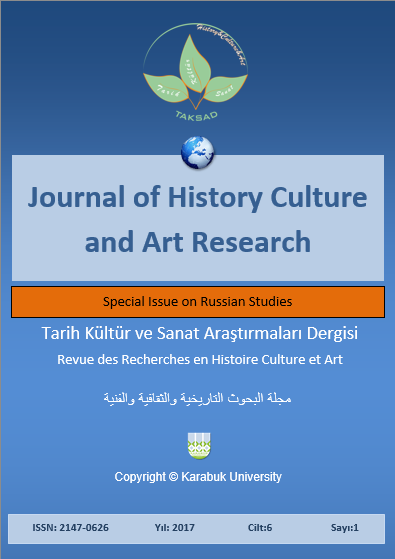Wind's Element in the Artistic World of Ivan Bunin: Semantic Strategies and Dominants
DOI:
https://doi.org/10.7596/taksad.v6i5.1305Keywords:
Literary image, Archetypes, Associative potential, Author’s meaning, Emotive dominants, Phenomenology of the context, World modeling, Cognitive structure.Abstract
The article considers the principles of systematization of the outer world in the author’s individual consciousness of I.A. Bunin and presents the description of personal imaginative nominations of elemental phenomena of nature. The research is based on the synthesis of traditional and modern methods of analysis for realization of a literary word: component, discourse-text analysis of names, as well as cognitive-hermeneutic text analysis, which made it possible to set up a correspondence existing between the units of the text, the information coded by them and the mental structures behind this information, or their elements by studying the character of the connections between them. The analyzed ways of verbalization of the author’s meanings at the level of contact and distant connections allow to reveal the cognitive-mental and emotive spheres of the writer’s consciousness, and also to interpret the phenomenon of Bunin’s Universe as a complex phenomenon that determines its uniqueness and originality in Russian literature. It is noted that the textual realization of words in literary discourse leads to the integration of various aspects of reality and recreates the author’s perception of the world, based on the inseparable, interpenetrating unity of the objective and subjective, the logical and sensual, the rational and emotional. The presented paradigm of the images of wind elicits the properties of its prototype and explicates new properties and attributes of the denotation on the basis of its systemic and non-systemic relationships arisen in the author’s consciousness. On the basis of the considered complex of associativesingsof the element of wind, the authors reveal Bunin’s understanding of the semantic multidimensionality of being, the complexity and versatile relations between man and the world.
References
Andramonova, N. A. & Usmanova, L. A. (2014). Ethnocultural Image Constants and their Discourse Literary Correlates. Journal of Language and Literature, 5(4), 65-68.
Fauconnier, G. (1994). Mental Spaces. Cambridge: Cambridge University Press.
Fillmore, C. J. (2010). Discussing frame semantics: The state of the art. An interview with Charles J. Fillmore. Review of cognitive linguistics, 8(1).
Gachev, G. D. (2007). Cosmo-Psycho-Logos: National Images of the World. Мoscow: Academic Project.
Guzel, M. N. & Liliya, A. U. (2016). The Idiostyle of I.A. Bunin: Emotive and Semantic Dominants in Description of Natural Phenomena. Journal of Language and Literature, 7(3), 199-202. ISSN: 2078-0303.
Guzel, M. N.; Liliya, A. U. & Dinara, I. R. (2016). The Use of Moderation Technology at Lessons of Russian Language as the Development of Pupils’ Cognitive Activity. The European Proceedings of Social and Behavioural Sciences (EpSBS), 12, July, 173-179.
Guzel, М. N. & Yusupova, Z. F. (2016). Studying Gender at the Lessons of Russian Language: Symbolic and Semantic Approaches. Journal of Language and Literature, 7(3), 124-127. ISSN: 2078-0303.
Meshcheryakovsa, О. А. (2011). Semantics of Perception in the Aspect of Literary Cognition of I.A. Bunin. Thesis for Doctor of Philology. Yelets.
Slivitskaya, О. V. (2004). The Heightened Sense of Life: The World of Ivan Bunin. Мoscow: Russian State Humanitarian University.
Spivak, R. S. (2016). Russian Philosophic Lyrics. The years of 1920s. I. Bunin, А. Blok, V. Mayakovsky: textbook. Мoscow: Flinta.
Svetlana, S. S. & Zamaliutdinova, E. R. (2016). Semantics and functioning of syntactic constructions in the mass media language. Journal of Language and Literature, 7(4), 160-164.
Turner, M. (1993). An image-schematic constraint on metaphor. In Geiger, R. A., & Rudzka-Ostyn, B. (eds.). Conceptualizations and Mental Processing in Language. Berlin, New York: Moutonde Gruyter.
Yusupova, Z. F. (2016). Dialogue of Cultures of Teaching of Russian as a foreign Language in the Chinese Audience: Approaches and Solutions. IFTE 2016 - 2nd International Forum on Teacher Education, 12, 203-207.
Downloads
Published
How to Cite
Issue
Section
License
All papers licensed under Creative Commons 4.0 CC-BY.- Share — copy and redistribute the material in any medium or format
- Adapt — remix, transform, and build upon the material for any purpose, even commercially.
Under the following terms:
Attribution — You must give appropriate credit, provide a link to the license, and indicate if changes were made. You may do so in any reasonable manner, but not in any way that suggests the licensor endorses you or your use.
- No additional restrictions — You may not apply legal terms or technological measures that legally restrict others from doing anything the license permits.







